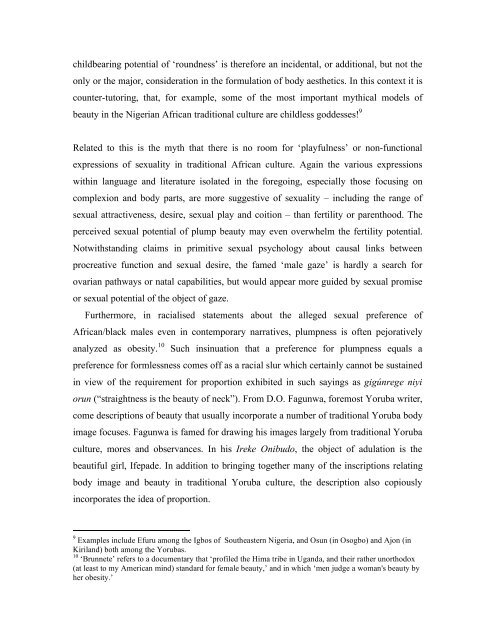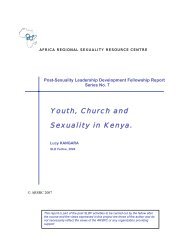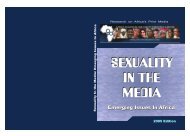body images beauty culture and language - Africa Regional ...
body images beauty culture and language - Africa Regional ...
body images beauty culture and language - Africa Regional ...
You also want an ePaper? Increase the reach of your titles
YUMPU automatically turns print PDFs into web optimized ePapers that Google loves.
childbearing potential of ‘roundness’ is therefore an incidental, or additional, but not the<br />
only or the major, consideration in the formulation of <strong>body</strong> aesthetics. In this context it is<br />
counter-tutoring, that, for example, some of the most important mythical models of<br />
<strong>beauty</strong> in the Nigerian <strong>Africa</strong>n traditional <strong>culture</strong> are childless goddesses! 9<br />
Related to this is the myth that there is no room for ‘playfulness’ or non-functional<br />
expressions of sexuality in traditional <strong>Africa</strong>n <strong>culture</strong>. Again the various expressions<br />
within <strong>language</strong> <strong>and</strong> literature isolated in the foregoing, especially those focusing on<br />
complexion <strong>and</strong> <strong>body</strong> parts, are more suggestive of sexuality – including the range of<br />
sexual attractiveness, desire, sexual play <strong>and</strong> coition – than fertility or parenthood. The<br />
perceived sexual potential of plump <strong>beauty</strong> may even overwhelm the fertility potential.<br />
Notwithst<strong>and</strong>ing claims in primitive sexual psychology about causal links between<br />
procreative function <strong>and</strong> sexual desire, the famed ‘male gaze’ is hardly a search for<br />
ovarian pathways or natal capabilities, but would appear more guided by sexual promise<br />
or sexual potential of the object of gaze.<br />
Furthermore, in racialised statements about the alleged sexual preference of<br />
<strong>Africa</strong>n/black males even in contemporary narratives, plumpness is often pejoratively<br />
analyzed as obesity. 10 Such insinuation that a preference for plumpness equals a<br />
preference for formlessness comes off as a racial slur which certainly cannot be sustained<br />
in view of the requirement for proportion exhibited in such sayings as gigúnrege niyi<br />
orun (“straightness is the <strong>beauty</strong> of neck”). From D.O. Fagunwa, foremost Yoruba writer,<br />
come descriptions of <strong>beauty</strong> that usually incorporate a number of traditional Yoruba <strong>body</strong><br />
image focuses. Fagunwa is famed for drawing his <strong>images</strong> largely from traditional Yoruba<br />
<strong>culture</strong>, mores <strong>and</strong> observances. In his Ireke Onibudo, the object of adulation is the<br />
beautiful girl, Ifepade. In addition to bringing together many of the inscriptions relating<br />
<strong>body</strong> image <strong>and</strong> <strong>beauty</strong> in traditional Yoruba <strong>culture</strong>, the description also copiously<br />
incorporates the idea of proportion.<br />
9<br />
Examples include Efuru among the Igbos of Southeastern Nigeria, <strong>and</strong> Osun (in Osogbo) <strong>and</strong> Ajon (in<br />
Kiril<strong>and</strong>) both among the Yorubas.<br />
10<br />
‘Brunnete’ refers to a documentary that ‘profiled the Hima tribe in Ug<strong>and</strong>a, <strong>and</strong> their rather unorthodox<br />
(at least to my American mind) st<strong>and</strong>ard for female <strong>beauty</strong>,’ <strong>and</strong> in which ‘men judge a woman's <strong>beauty</strong> by<br />
her obesity.’






